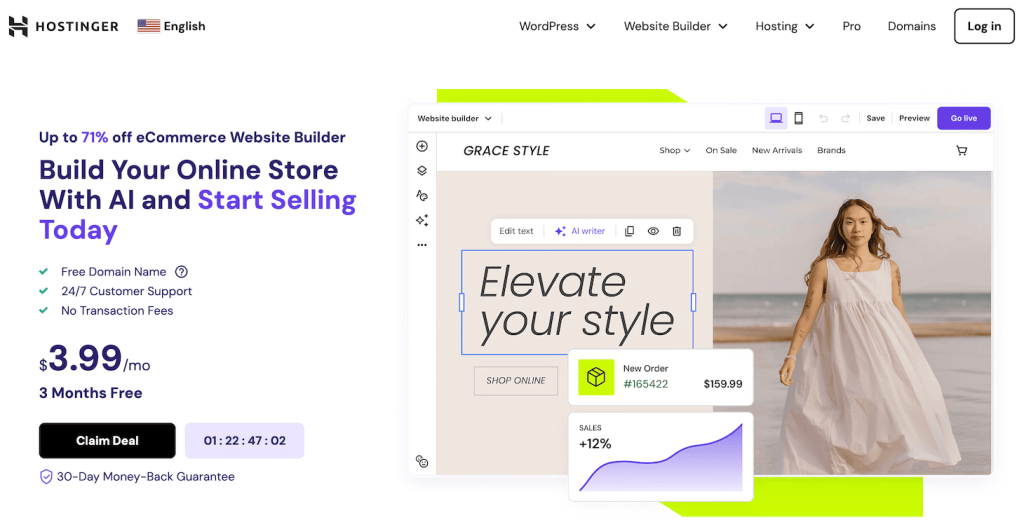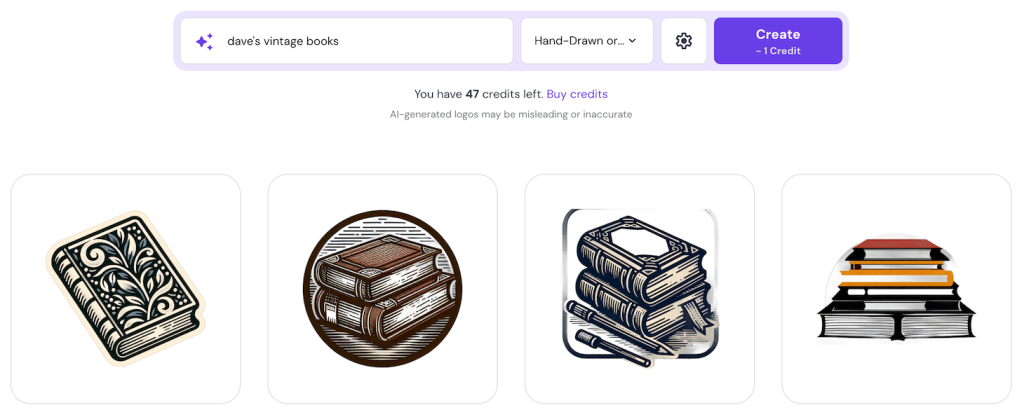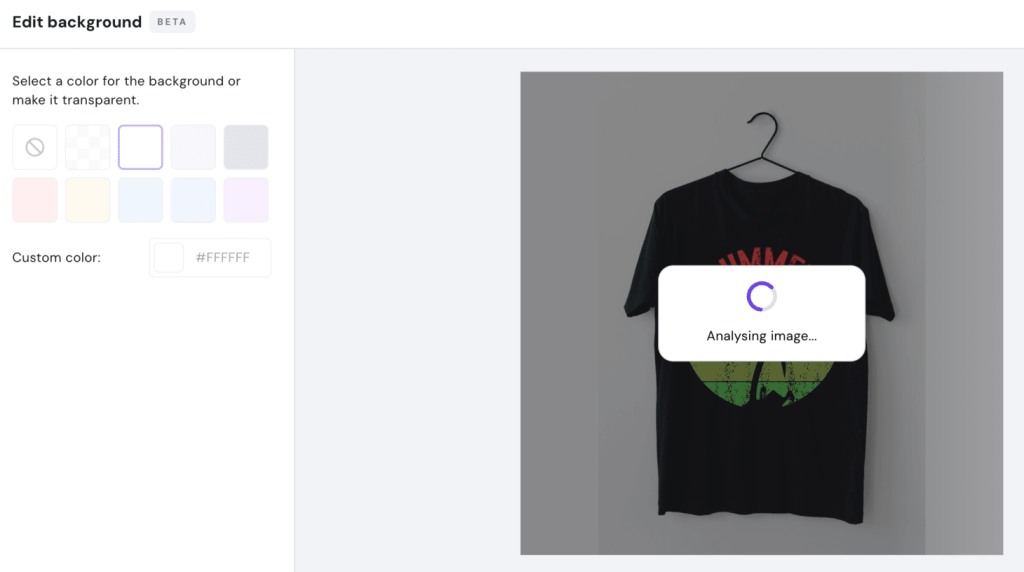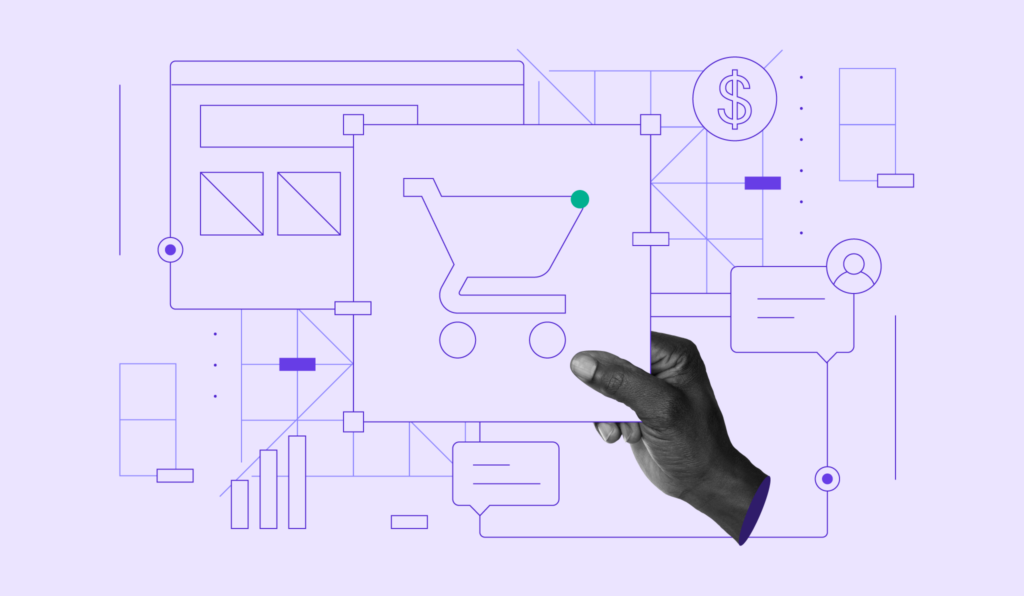How to start an online thrift store in 11 steps
Whether you love giving vintage items a second life or have a passion for sustainable fashion, starting an online thrift store can be a profitable business venture.
Even if you’re a beginner with no business experience, you can launch your own store quickly and without a big budget.
This guide will walk you through the 11 key steps to starting your online thrift store, including finding your niche, identifying the right ways to set up your store, and implementing an effective marketing strategy.
Download website launch checklist
How to start an online thrift store
Starting an online thrift store is possible for anyone, even if you’ve never run a business before. Let’s explore how to launch your new, thriving business.
1. Find your niche
Identifying your niche is the first step in building a profitable online thrift store.
Combining the strategies below will help you find the sweet spot where your interests match market needs.
Tap into your interests
Think about the secondhand items you are passionate about or areas you have unique insights about, as this can help you stand out. For example, if you love classic video games, consider opening a thrift store focusing on retro gaming equipment.
Analyze market trends
Use tools like Google Trends to identify the type of secondhand items people search for. Complement these insights with data from industry authorities like ThredUp’s annual Resale Report, where you can identify growing market segments.
Look for gaps in the current market.
Use social media to uncover discussions about online thrift stores. On X, search for keywords like thrifting, secondhand, or sustainable fashion and read through discussions. Browse Reddit communities like r/ThriftStoreHauls or r/Flipping. On Instagram, follow thrift influencers and check their comments sections. Look for customers expressing pain points and identify areas for improvement.
Study popular online thrift stores
Identify competitor offers in popular categories to see what is selling well. Read reviews on their website or Trustpilot to understand common complaints and pinpoint areas that resonate with their shoppers. This competitor research will help you identify areas where you can differentiate your thrift store.
2. Set up your online thrift store
Setting up your online thrift store doesn’t have to be complicated. The two main options are selling through online marketplaces or eCommerce platforms.
The best way to set up your store depends on your goals and budget. Let’s explore both options to see which makes the most sense for your situation.
Online marketplaces
An online marketplace might be a good option if you want to get started quickly and sell a limited number of items.

Let’s look into their pros and cons:
Pros
- Easy setup. Marketplaces like Etsy or eBay allow you to set up your thrift store quickly. In most cases, you just need to register, create product listings, and upload photos.
- Built-in audience. These platforms already have an established audience, making it easy for you to reach potential buyers and sell online.
Cons
- Tough competition. These marketplaces display your products alongside other sellers, making it challenging to stand out.
- Fees on every sale. Most marketplaces charge listing fees and transaction fees. For example, eBay charges $0.30/order and up to 15.55% of each sale, while Etsy has a $0.20 listing fee and a 5% transaction fee. These fees can significantly cut into your profits. If you sell a vintage book on eBay for $20, you end up getting only $16.59, and your payment provider might also charge a fee.
- Limited branding control. One of the most significant disadvantages of using online marketplaces is that you have limited control over branding and the customer journey with your store. For example, you usually have to use pre-defined templates and layouts. This means you won’t be able to fully express your brand’s identity and stand out from competitors.
eCommerce platforms
The other option is making an online store with an eCommerce platform like Hostinger’s online store builder.

Here’s why this can be a great long-term solution for your online thrift store:
Pros
- Complete control over your store. Building your own website gives you complete control over your brand’s presentation. You can design your store with a personalized domain name and design to match your vision.
- Don’t pay fees on each sale. When you sell directly from your site, you avoid the fees and commissions most online marketplaces charge for each sale. This potentially allows you to earn higher profit margins. If you sell that same vintage book for $20 on your own website, you keep the full amount without sharing anything with the platform.
- No technical skills required. Creating a website in the past involved knowing how to code and a highly technical setup. Now, with Hostinger Website Builder, you can start an online store in minutes with the help of AI. All you need to do is describe your store and let AI do the rest.
- Customers focus on your products. With your site, customers only see your products. You won’t have to compete against other sellers for attention or potentially lose sales if the marketplace recommends a similar product at a lower price.
Cons
- No existing customer base. While online marketplaces have established audiences, you might not have any traffic when you build your site. You must invest time and effort into marketing your store to build your audience. Fortunately, this isn’t complicated, and we’ve outlined some effective marketing strategies for you to try in this guide.
Deciding where to set up your online thrift store
When deciding where to set up your online thrift store business, consider your budget, long-term goals, and the time you want to invest.
If you’re on a tight budget, online marketplaces present a good option as you don’t have to invest money upfront. However, you will pay various fees for each sale you make, which will significantly cut your profit margins in the long term.
On the other hand, setting up your store with Hostinger Website Builder requires a small initial investment of ₱169.00/month with significant savings over 48 months. However, since you do not need to pay fees or commissions on each sale, this investment is a minimal startup cost that pays itself back through higher profit margins.
Hostinger Website Builder also makes setting up your site incredibly easy. All you need to do is describe your thrift store idea and let AI create a website you can easily personalize with the simple drag-and-drop editor. No tech skills required.

In addition, if you want full control over your brand and how your products are presented, setting up your own online store makes a lot of sense.
Here is our final recommendation:
- Online marketplaces – best for quickly selling a few products without building a brand or a great starting point if you don’t have the budget for creating a site.
- eCommerce platforms – best for those who want to start a business and have long-term goals.
3. Create your brand
A well-crafted store brand helps you stand out from competitors and create a positive impression on your potential customers.
Here are some tips for creating a great brand:
Choose a memorable business name
Find a name that hints at your store’s specialty, whether vintage, trendy, or sustainable. Ensure it is easy to pronounce and remember while avoiding names that are too similar to existing brands.
Create a consistent style
Start with a simple logo that people can easily remember. With Hostinger Website Builder, you can quickly create a memorable logo with AI. Choose colors and fonts that fit your store’s style, and use this same style throughout your website and social media.

Align your brand message with your audience
A strong brand message clearly communicates what makes your store unique and what it stands for. These values will help you attract your ideal audience by aligning with their needs and preferences. Maintain a consistent tone across all platforms to effectively communicate your brand’s values and story.
The brand you create should represent the purpose of your store. A strong brand can attract and retain customers while building trust and loyalty.
4. Source great products
Once you’ve set up your online thrift store, you should use diverse strategies to source great products effectively. However, be sure to focus only on products that align with your niche and appeal to your target audience.
Here are several effective ways to source great products for your customers:
- Garage sales. Local garage sales are often full of hidden gems, especially in affluent neighborhoods. Arrive early for the best selection of items, and look for underpriced products that could be valuable to your customers.
- Estate sales. These can often yield high-quality, vintage items. Check websites like EstateSales.org for upcoming sales in your area. Many of these sales are auction-based, so think about a price range you are comfortable with before bidding.
- Other thrift stores. Visit thrift stores in your area and look for stores closing or relocating, as they may offer bulk discounts. Build relationships with other store owners to be notified of future inventory that fits your niche.
- Flea markets. These are a great source of undervalued items you can resell online. Arrive early and bring cash to make it easier to bargain with sellers. Identify and build relationships with regular vendors who can give you the first pick of new inventory.
- Wholesalers. Research and find suppliers of overstock, closeout, or liquidation items. These suppliers often have excess inventory that they want to sell in bulk.
Remember to start small
It’s easy to get caught up in the excitement of exploring sales to find one product your customers will love. However, you need to remember to start small.
First, focus on acquiring a small collection of great products. This will allow you to manage inventory effectively while gaining insights into customer preferences.
You can expand your inventory once you’ve established your brand and identified what your customers want.
5. Store and manage your products
Effective storage is essential to ensure your inventory remains in good condition until sold.
Storing your products at home likely makes the most sense when starting. Use the garage, basement, spare room, or empty shelves. This can be a cost-effective option that makes it easy to access and manage products.
Renting a storage unit could be beneficial if you don’t have space at home. Most storage units are climate-controlled, which protects items from temperature and humidity. They also offer advanced security features like surveillance cameras and gated access. Choose a unit that is conveniently located and allows for flexible access.
Regardless of where you store your inventory, staying organized is important. Here are some essential tips to remember:
- Match storage categories to website categories. Separate your products based on their categories on your online store. Use shelves, racks, bins, and boxes to keep items organized and clearly label everything.
- Conduct regular inventory audits. Verify stock levels and identify any discrepancies. This helps you maintain accurate stock levels and prevents overselling.
- Use an inventory management system. Start with a simple spreadsheet where you track how many products you have, how long they’ve been in storage, and how they are categorized.
Creating a well-organized storage system can contribute significantly to your success. By remaining diligent and paying attention to the details, you can streamline your process and enjoy running your business.
6. Take great product photos
High-quality product photos are vital to building trust with visitors and converting them into buyers.
In a physical thrift store, customers can touch and examine products closely. With an online thrift store, product photos are the closest thing customers have to touch or try out the products, so they must make a great impression on potential customers.
To take exceptional product photos, here are essential factors to keep in mind:
- Good lighting. Natural lighting works best for clear photos, so try shooting during daylight hours. Consider investing in a simple lightbox if natural light isn’t readily available.
- Simple background. Use a neutral-colored background to help your products stand out. To keep backgrounds consistent and overall store design clear, Hostinger Website Builder comes with AI Background Remover.

- Multiple angles. Give your customers a comprehensive view of your products with photos from the front and back, sides, and close-ups of important details. Be sure to include pictures of any flaws to maintain transparency and build trust with shoppers.
- Consistency. Maintain a consistent style across all your product photos to enhance visitors’ shopping experience.
- Photo editing. Use simple tools like PicMonkey or Canva to further highlight your products with simple edits like adjusting the brightness or cropping images.
7. Price your products appropriately
Determining the right product price involves carefully considering several factors, including your costs to acquire the product and how competitors price similar items.
Let’s dive into the essential elements to help correctly price your products.
- Cover your costs. Calculate the total costs of each product, including the price you paid for it, any travel or auction fees, as well as packaging and shipping the item to the buyer. To maintain profitability, ensure your selling price is higher than these costs.
- Check competitor prices. Find similar products on other online thrift stores or marketplaces like eBay or Etsy to determine a competitive price range. Then, consider various factors that will help you settle on a price within that range, including the product’s condition, unique features, and market trends.
- Use strategic pricing. Selling involves presentation and perception, which is also the case with pricing. To create the perception of value, use prices that end in 99, such as $9.99 instead of $10 or $99 instead of $100. This pricing strategy gives the impression that the product is discounted or significantly lower, even though the difference is marginal.
- Factor in any seasonal demands. Some products might command higher prices during certain times throughout the year, such as backpacks and school supplies when students prepare to return to school or camping gear and outdoor equipment in spring and summer.
- Remain dynamic with pricing. Adjust your prices based on demand, the time products have been listed without being sold, and market conditions.
When you carefully consider these factors, you can determine a pricing range that will help cover your costs and reflect the true value of your unique products.
8. Set up shipping
A seamless shipping process is another critical component of a successful online thrift store business.
From managing costs to working with the right logistics partners, your shipping decisions can significantly impact your profitability and customer satisfaction.
Let’s explore the key elements of a robust shipping system:
- Logistics partners. Compare rates and services different shipping carriers provide to find a partner that aligns with your budget and delivery expectations.
- Shipping costs. Negotiate discounts with carriers for bulk shipments and consider flat-rate or free shipping thresholds to encourage larger purchases.
- Appropriate packaging. Suitable packaging materials will help protect products during transit, which is especially important for vintage or fragile items. Consider eco-friendly packaging options to appeal to sustainable values.
- Delivery time. Communicate clear and realistic expectations to customers about delivery times, considering the time it takes to prepare the items for shipping.
9. Market your online thrift store
Marketing is vital to driving traffic and making sales for your online thrift store. Your marketing efforts help to introduce potential customers to your store, highlight what makes your products unique, and inform people about the benefits of thrift shopping.
Here are several effective marketing strategies for you to try:
Search engine optimization (SEO)
Use tools like Google Keyword Planner to research and identify relevant keywords for your content and product descriptions. Adding those keywords to your website will help people discover your site on search engines.
To climb even higher on search engines like Google, ensure your site loads quickly and is responsive. Luckily, all websites built with our AI Builder are mobile-friendly by default.
Social media marketing
Use platforms like Instagram, TikTok, and Facebook to build a following of potential customers. Share unique photos and videos of your products and engage with your community. Encourage people to share your content and post photos of their purchases. Use relevant hashtags to increase visibility and take advantage of trending items or styles.
Paid advertising
If you have a marketing budget, consider running Google Ads or social media ads on Facebook and Instagram. You can target specific keywords related to your products or particular users interested in your products. Paid advertising can help you reach targeted audiences, but testing ad performance and staying on top of your costs is essential.
Influencer partnerships
Team up with complementary businesses, such as those in sustainable fashion or social media influencers with an audience passionate about thrifting. Offer an affiliate commission for all sales they send your way.
When you implement any of these marketing strategies, it’s vital to maintain a consistent brand voice across all channels. Tracking and analyzing performance to see what works best for your store and adapting your strategy based on customer feedback are just as important.
10. Provide excellent customer service
Outstanding customer service is fundamental to the success of any online thrift store. It helps to assure customers that they can trust your store and encourages them to recommend it to others.
Here are some easy ways to create a positive experience for customers:
Offer multiple communication channels
Provide email support for more detailed inquiries, live chat support for quick questions, and have an FAQ section on your website for the most common questions. This is all possible with Hostinger Website Builder where you can easily set up a contact form for email communication, live chat with WhatsApp or Facebook Messenger, and create a page for FAQs. This caters to a range of customer preferences and shows you’re willing to make finding answers easy and convenient.
Respond promptly to customer inquiries
Quick responses show customers that you care about them, help prevent frustration, and can help avoid negative reviews. Set clear expectations around response times, that way customers know to expect a response within 24 hours, for example, instead of immediately.
Have simple return and exchange policies
Make the return process simple and easy to follow, offer a reasonable return timeframe, and clearly communicate your policies on your website. The more transparent you are, the more trust your customers will likely have and the more confidence it demonstrates in your products.
Excellent customer service doesn’t have to be complicated. It begins with proactively anticipating potential customer needs and questions and addressing them before they arise.
11. Monitor and analyze your business performance
Tracking key performance metrics is vital for the success and growth of your online thrift store. Regularly analyzing your store’s performance lets you understand what’s working and where to improve.
Key metrics to track
Here are the primary data points to monitor:
- Sales performance. Identifying which products are selling well can help you focus on sourcing popular items instead of those not selling well. This can also mean focusing more on specific niche segments if they are more popular.
- Website traffic. Monitoring website traffic will help you understand where your visitors are coming from and allow you to concentrate your marketing efforts better. When your time is limited, you only want to put effort into the most effective marketing strategies.
- Conversion rates. Understanding how many visitors convert to buyers in your store gives you an idea of how you can improve the customer experience. Factors that can improve conversion rates include better photos, more engaging product descriptions, pricing strategies, and shipping policies.
- Customer behavior. Determining whether buyers become repeat customers or noticing increased returns will give you an idea of overall customer satisfaction. This, in turn, will indicate what needs to be improved, like whether you can offer more complementary products or if you need to provide more transparent descriptions to manage customer expectations.
Best tools for tracking performance
There are numerous tools available to help you track sales data. Here are the most effective:
- Google Analytics. A free tool that provides detailed insights into website traffic sources and user behavior.
- HotJar. Offers an advanced suite of tools to understand how people use your site.
- Hostinger Website Builder. Offers a comprehensive view of sales performance, traffic, and user behavior with advanced tools like AI Heatmap, which helps you identify which areas of the site your visitors focus on. These insights can help you drastically improve user experience and conversion rates. You can also set up various third-party tools, including Google Analytics.

Conclusion
Launching your online thrift store is an exciting journey. With your passion and the strategies outlined in this guide, you are well on your way to making a mark.
Let’s recap the steps:
- Identify your niche. Conduct market research and explore your interests to find your niche.
- Set up your online thrift store. Explore the different platforms and identify which one aligns best with your goals.
- Create your brand. Create a memorable business name and design a logo representing your store.
- Source your products. Use diverse strategies to source products that align with your niche effectively.
- Store and manage your products. Create a well-organized storage system to ensure your products remain in good condition.
- Take great product photos. Showcase your products in the best possible way with professional-looking pictures.
- Price your products. Determine a fair price for your products by factoring in your costs, competitor prices, and any unique product features.
- Set up shipping. A reliable shipping process involves finding suitable shipping carriers and using appropriate packaging.
- Market your online thrift store. Use various effective marketing strategies, such as SEO, social media marketing, paid advertising, and influencer partnerships.
- Provide excellent customer service. Communicate proactively and promptly with your customers to give them a positive experience.
- Monitor and analyze your business performance. Analyze your performance data to make informed decisions about what works well and what can be improved.
Remember to start small, learn and improve as you go, and celebrate all the small wins. We can’t wait to see what you create.
How to start an online thrift store FAQ
Is an online thrift store profitable?
An online thrift store can be profitable, but its success depends on various factors. Finding a great niche, sourcing in-demand items, and providing exceptional customer service are a few vital factors for profitability.
How much can online thrift stores make?
Earnings from a profitable online thrift store vary widely, from a few hundred dollars a month to substantially more for well-established businesses. Many factors impact how much you can make, including the quality and quantity of your inventory, your profit margins, and the effectiveness of your marketing.
How much does it cost to start an online thrift store?
The primary costs you will incur to start your online thrift store are the eCommerce platform you use, your domain name, and your initial inventory. It’s a good idea to start small to understand what sells well before investing more and scaling up.


